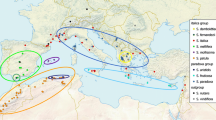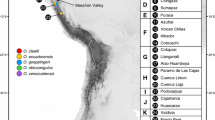Abstract
Patterns of diversity reflect the balance between speciation and extinction over time. Here we estimate net diversification rates for samples of sexual and asexual rotifers using phylogenetic reconstructions from sequence data of one mtDNA locus, cytochrome oxidase c subunit I. All four clades of bdelloid rotifers, obligate asexuals, had higher number of species per clade and significantly higher accumulation of diversification events towards the root of the trees than the four clades of their sexual relatives, the monogonont rotifers. Such differences were robust to confounding effects of number of analysed sequences, haplotype diversity, overall genetic divergence, age of the clades or geographic coverage. Our results support the idea that differences in diversification rates could thus be ascribed to different mechanisms of speciation, with ecological speciation as the most plausible mechanism for asexual organisms.

Similar content being viewed by others
References
Alfaro, M. E., Santini, F., & Brock, C. D. (2007). Do reefs drive diversification in marine teleosts? Evidence from the pufferfish and their allies (order Tetraodontiformes). Evolution, 61, 2104–2126.
Artois, T., Fontaneto, D., Hummon, W. D., McInnes, S. J., Todaro, M. A., Sørensen, M. V., et al. (2011). Ubiquity of microscopic animals? Evidence from the morphological approach in species identification. In D. Fontaneto (Ed.), Biogeography of microscopic organisms, is everything small everywhere? (pp. 244–283). Cambridge: Cambridge University Press.
Baer, A., Langdon, C., Mills, S., Schulz, C., & Hamre, K. (2008). Particle size preference, gut filling and evacuation rates of the rotifer Brachionus ‘Cayman’ using polystyrene latex beads. Aquaculture, 282, 75–82.
Birky, C. W. Jr & Barraclough, T. G. (2009). Asexual speciation. In I. Scon, K. Martens & P. van Dijk (Eds.), Lost sex: The evolutionary biology of parthenogenesis (pp. 201–216). Dordrecht: Springer.
Barraclough, T. G., Birky, C. W., & Burt, A. (2003). Diversification in sexual and asexual organisms. Evolution, 57, 2166–2172.
Barraclough, T. G., Fontaneto, D., Ricci, C., & Herniou, E. A. (2007). Evidence for inefficient selection against deleterious mutations in cytochrome oxidase I of asexual bdelloid rotifers. Molecular Biology and Evolution, 24, 1952–1962.
Birky, C. W., Jr, Wolf, C., Maughan, H., Herbertson, L., & Henry, E. (2005). Speciation and selection without sex. Hydrobiologia, 546, 29–45.
Birky, C. W., Jr, Adams, J., Gemmel, M., & Perry, J. (2010). Using population genetic theory and DNA sequences for species detection and identification in asexual organisms. PLoS ONE, 5(5), e10609.
Bode, S. N. S., Adolfsson, S., Lamatsch, D. K., Martins, M. J. F., Schmit, O., Vandekerkhove, J., et al. (2010). Exceptional cryptic diversity and multiple origins of parthenogenesis in a freshwater ostracod. Molecular Phylogenetics and Evolution, 54, 542–552.
Briski, E., Cristescu, M. E., Bailey, S. A., & MacIsaac, H. J. (2011). Use of DNA barcoding to detect invertebrate invasive species from diapausing eggs. Biological Invasions, 13, 1325–1340.
Brock, C. D., Harmon, L. J., & Alfaro, M. E. (2011). Testing for temporal variation in diversification rates when sampling is incomplete and non-random. Systematic Biology, 60, 410–419.
Campillo, S., Garcia-Roger, E. M., Martinez-Torres, D., & Serra, M. (2005). Morphological stasis of two species belonging to the L-morphotype in the Brachionus plicatilis species complex. Hydrobiologia, 546, 181–187.
Colwell, R. K., & Coddington, J. A. (1994). Estimating terrestrial biodiversity through extrapolation. Philosophical Transactions of the Royal Society of London B, 345, 101–118.
Crawley, M. J. (2007). The R book. Chichester: Wiley.
Cusimano, N., & Renner, S. S. (2010). Slowdowns in diversification rates from real phylogenies may not be real. Systematic Biology, 59, 458–464.
Derry, A. M., Hebert, P. D. N., & Prepas, E. E. (2003). Evolution of rotifers in saline and subsaline lakes: A molecular phylogenetic approach. Limnology and Oceanography, 48, 675–685.
Fontaneto, D., Herniou, E. A., Boschetti, C., Caprioli, M., Melone, G., Ricci, C., et al. (2007). Evidence for independently evolving species in bdelloid rotifers. PLoS Biology, 5, 914–921.
Fontaneto, D., Barraclough, T. G., Chen, K., Ricci, C., & Herniou, E. A. (2008). Molecular evidence for broad-scale distributions in bdelloid rotifers: Everything is not everywhere but most things are very widespread. Molecular Ecology, 17, 3136–3146.
Fontaneto, D., Kaya, M., Herniou, E. A., & Barraclough, T. G. (2009). Extreme levels of hidden diversity in microscopic animals (Rotifera) revealed by DNA taxonomy. Molecular Phylogenetics and Evolution, 53, 182–189.
Fontaneto, D., Iakovenko, N., Eyres, I., Kaya, M., Wyman, M., & Barraclough, T. G. (2011). Cryptic diversity in the genus Adineta Hudson & Gosse, 1886 (Rotifera: Bdelloidea: Adinetidae): A DNA taxonomy approach. Hydrobiologia, 662, 27–33.
Fordyce, J. A. (2010). Interpreting the γ statistic in phylogenetic diversification rate studies: A rate decrease does not necessarily indicate an early burst. PLoS ONE, 5(7), e11781.
Gilbert, J. J., & Walsh, E. J. (2005). Brachionus calyciflorus is a species complex: Mating behavior and genetic differentiation among four geographically isolated strains. Hydrobiologia, 546, 257–265.
Gómez, A., Carvalho, G. R., & Lunt, D. H. (2000). Phylogeography and regional endemism of a passively dispersing zooplankter: Mitochondrial DNA variation in rotifer resting egg banks. Proceedings of the Royal Society of London B, 267, 2189–2197.
Gómez, A., Serra, M., Carvalho, G. R., & Lunt, D. H. (2002). Speciation in ancient cryptic species complexes: Evidence from the molecular phylogeny of Brachionus plicatilis (Rotifera). Evolution, 56, 1431–1444.
Gómez, A., Montero-Pau, J., Lunt, D. H., Serra, M., & Campillo, S. (2007). Persistent genetic signatures of colonization in Brachionus manjavacas rotifers in the Iberian Peninsula. Molecular Ecology, 16, 3228–3240.
Guindon, S., & Gascuel, O. (2003). A simple, fast and accurate algorithm to estimate large phylogenies by maximum likelihood. Systematic Biology, 52, 696–704.
Harmon, L. J., Schulte, J. A., Larson, A., & Losos, J. B. (2003). Tempo and mode of evolutionary radiation in iguanian lizards. Science, 301, 961–964.
Heethoff, M., Domes, K., Laumann, M., Maraun, M., Norton, R. A., & Scheu, S. (2007). High genetic divergences indicate ancient separation of parthenogenetic lineages of the oribatid mite Platynothrus peltifer (Acari, Oribatida). Journal of Evolutionary Biology, 20, 392–402.
Kaya, M., Herniou, E. A., Barraclough, T. G., & Fontaneto, D. (2009). Inconsistent estimates of diversity between traditional and DNA taxonomy in bdelloid rotifers. Organisms, Diversity and Evolution, 9, 3–12.
Keane, T. M., Creevey, C. J., Pentony, M. M., Naughton, T. J., & Mclnerney, J. O. (2006). Assessment of methods for amino acid matrix selection and their use on empirical data shows that ad hoc assumptions for choice of matrix are not justified. BMC Evolutionary Biology, 6, 29.
Lowe, C. D., Kemp, S. J., Diaz-Avalos, C., & Montagnes, D. J. S. (2007). How does salinity tolerance influence the distributions of Brachionus plicatilis sibling species? Marine Biology, 150, 377–386.
Maynard Smith, J. (1978). The evolution of sex. New York, NY: Cambridge University Press.
McLeish, M. J., Van Noort, S., & Tolley, K. A. (2010). Parasitoid fig-wasp evolutionary diversification and variation in ecological opportunity. Molecular Ecology, 19, 1483–1496.
McPeek, M. A. (2008). The ecological dynamics of clade diversification and community assembly. American Naturalist, 172, E270–E284.
Mills, S., Lunt, D. H., & Gómez, A. (2007). Global isolation by distance despite strong regional phylogeography in a small metazoan. BMC Evolutionary Biology, 7, 225.
Orr, H. A. (2000). The rate of adaptation in asexuals. Genetics, 155, 961–968.
Otto, S. P., & Lenormand, T. (2002). Resolving the paradox of sex and recombination. Nature Reviews Genetics, 2, 252–261.
Papakostas, S., Dooms, S., Christodoulou, M., Triantafyllidis, A., Kappas, I., Dierckens, K., et al. (2006). Identification of cultured Brachionus rotifers based on RFLP and SSCP Screening. Marine Biotechnology, 8, 547–559.
Paradis, E., Bolker, B., Claude, J., Cuong, H. S., Desper, R., Durand, B., Dutheil, J., Gascuel, O., Heibl, C., Lawson, D., Lefort, V., Legendre, P., Lemon, J., Noel, Y., Nylander, J., Opgen-Rhein, R., Schliep, K., Strimmer, K. & de Vienne, D. (2011). Package ape 2.7-3. Analyses of Phylogenetics and Evolution. http://ape.mpl.ird.fr/.
Phillimore, A. B., & Price, T. D. (2008). Density-dependent cladogenesis in birds. PLoS Biology, 6(3), e71.
Pons, J., Barraclough, T. G., Gomez-Zurita, J., Cardoso, A., Duran, D. P., Hazell, S., et al. (2006). Sequence based species delimitation for the DNA taxonomy of undescribed insects. Systematic Biology, 55, 595–609.
Pybus, O. G., & Harvey, P. H. (2000). Testing macro-evolutionary models using incomplete molecular phylogenies. Proceedings of the Royal Society of London B, 267, 2267–2272.
R Development Core Team. (2011). R: A language and environment for statistical computing. Vienna, Austria. Available from http://www.R-project.org.
Rabosky, D. L. (2009). Ecological limits on clade diversification in higher taxa. American Naturalist, 173, 662–674.
Rabosky, D. L., & Lovette, I. J. (2008). Density-dependent diversification in North American wood warblers. Proceedings of the Royal Society of London B, 275, 2363–2371.
Ricklefs, R. E. (2006). Global variation in the diversification rate of passerine birds. Ecology, 87, 2468–2478.
Ricklefs, R. E. (2007). Estimating diversification rates from phylogenetic information. Trends in Ecology & Evolution, 22, 601–610.
Sanderson, M. J. (2002). Estimating absolute rates of molecular evolution and divergence times: A penalized likelihood approach. Molecular Biology and Evolution, 19, 101–109.
Schluter, D. (2000). The ecology of adaptive radiation. New York, NY: Oxford University Press.
Schon, I., Martens, K., & van Dijk, P. (2009). Lost sex: The evolutionary biology of parthenogenesis. Dordrecht: Springer.
Schwander, T., & Crespi, B. J. (2008). Twigs on the tree of life? Neutral and selective models for integrating macroevolutionary patterns with microevolutionary processes in the analysis of asexuality. Molecular Ecology, 18, 28–42.
Sorensen, M. V., & Giribet, G. (2006). A modern approach to rotiferan phylogeny: Combining morphological and molecular data. Molecular Phylogenetics and Evolution, 40, 585–608.
Suatoni, E., Vicario, S., Rice, S., Snell, T., & Caccone, A. (2006). An analysis of species boundaries and biogeographic patterns in a cryptic species complex: The rotifer Brachionus plicatilis. Molecular Phylogenetics and Evolution, 41, 86–98.
Swanstrom, J., Chen, K., Castillo, K., Barraclough, T. G., & Fontaneto, D. (2011). Testing for evidence of inefficient selection in bdelloid rotifers: Do sample size and heterogeneity matter? Hydrobiologia, 662, 19–25.
Valente, L. M., Savolainen, V., & Vargas, P. (2010). Unparalleled rates of species diversification in Europe. Proceedings of the Royal Society of London B, 277, 1489–1496.
Wallace, R. L., Snell, T. W., Ricci, C. & Nogrady, T. (2006). Rotifera, biology, ecology and systematics. (2nd ed.). Guides to the Identification of the microinvertebrates of the continental waters of the world, 23. Ghent, Leiden: Kenobi Productions, Backhuys Publishers.
Wilke, T., Schultheiß, R., & Albrecht, C. (2009). As time goes by: A simple fool’s guide to molecular clock approaches in invertebrates. American Malacological Bulletin, 27, 25–45.
Xiang, X. L., Xi, Y. L., Wen, X. L., Zhang, J. Y., & Ma, Q. (2010). Spatial patterns of genetic differentiation in Brachionus calyciflorus species complex collected from East China in summer. Hydrobiologia, 638, 67–83.
Xiang, X. L., Xi, Y. L., Wen, X. L., Zhang, G., Wang, J. X., & Hu, K. (2011). Genetic differentiation and phylogeographical structure of the Brachionus calyciflorus complex in eastern China. Molecular Ecology, 20, 3027–3044.
Author information
Authors and Affiliations
Corresponding author
Rights and permissions
About this article
Cite this article
Fontaneto, D., Tang, C.Q., Obertegger, U. et al. Different Diversification Rates Between Sexual and Asexual Organisms. Evol Biol 39, 262–270 (2012). https://doi.org/10.1007/s11692-012-9161-z
Received:
Accepted:
Published:
Issue Date:
DOI: https://doi.org/10.1007/s11692-012-9161-z




